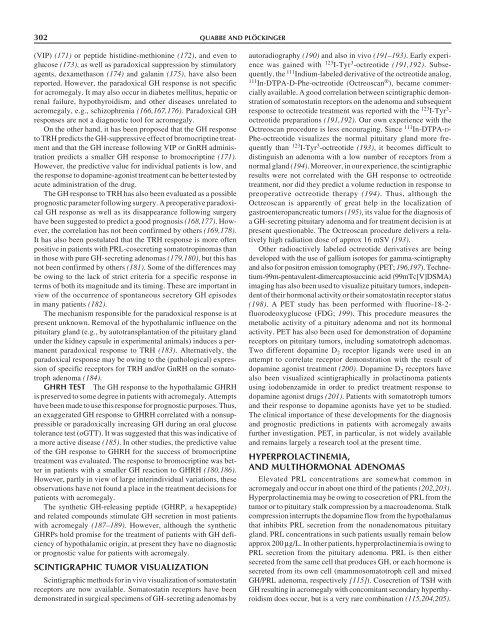Diagnosis and Management of Pituitary Tumors
Diagnosis and Management of Pituitary Tumors
Diagnosis and Management of Pituitary Tumors
You also want an ePaper? Increase the reach of your titles
YUMPU automatically turns print PDFs into web optimized ePapers that Google loves.
302 QUABBE AND PLÖCKINGER(VIP) (171) or peptide histidine-methionine (172), <strong>and</strong> even toglucose (173), as well as paradoxical suppression by stimulatoryagents, dexamethason (174) <strong>and</strong> galanin (175), have also beenreported. However, the paradoxical GH response is not specificfor acromegaly. It may also occur in diabetes mellitus, hepatic orrenal failure, hypothyroidism, <strong>and</strong> other diseases unrelated toacromegaly, e.g., schizophrenia (166,167,176). Paradoxical GHresponses are not a diagnostic tool for acromegaly.On the other h<strong>and</strong>, it has been proposed that the GH responseto TRH predicts the GH-suppressive effect <strong>of</strong> bromocriptine treatment<strong>and</strong> that the GH increase following VIP or GnRH administrationpredicts a smaller GH response to bromocriptine (171).However, the predictive value for individual patients is low, <strong>and</strong>the response to dopamine-agonist treatment can be better tested byacute administration <strong>of</strong> the drug.The GH response to TRH has also been evaluated as a possibleprognostic parameter following surgery. A preoperative paradoxicalGH response as well as its disappearance following surgeryhave been suggested to predict a good prognosis (168,177). However,the correlation has not been confirmed by others (169,178).It has also been postulated that the TRH response is more <strong>of</strong>tenpositive in patients with PRL-cosecreting somatotropinomas thanin those with pure GH-secreting adenomas (179,180), but this hasnot been confirmed by others (181). Some <strong>of</strong> the differences maybe owing to the lack <strong>of</strong> strict criteria for a specific response interms <strong>of</strong> both its magnitude <strong>and</strong> its timing. These are important inview <strong>of</strong> the occurrence <strong>of</strong> spontaneous secretory GH episodesin many patients (182).The mechanism responsible for the paradoxical response is atpresent unknown. Removal <strong>of</strong> the hypothalamic influence on thepituitary gl<strong>and</strong> (e.g., by autotransplantation <strong>of</strong> the pituitary gl<strong>and</strong>under the kidney capsule in experimental animals) induces a permanentparadoxical response to TRH (183). Alternatively, theparadoxical response may be owing to the (pathological) expression<strong>of</strong> specific receptors for TRH <strong>and</strong>/or GnRH on the somatotrophadenoma (184).GHRH TEST The GH response to the hypothalamic GHRHis preserved to some degree in patients with acromegaly. Attemptshave been made to use this response for prognostic purposes. Thus,an exaggerated GH response to GHRH correlated with a nonsuppressibleor paradoxically increasing GH during an oral glucosetolerance test (oGTT). It was suggested that this was indicative <strong>of</strong>a more active disease (185). In other studies, the predictive value<strong>of</strong> the GH response to GHRH for the success <strong>of</strong> bromocriptinetreatment was evaluated. The response to bromocriptine was betterin patients with a smaller GH reaction to GHRH (180,186).However, partly in view <strong>of</strong> large interindividual variations, theseobservations have not found a place in the treatment decisions forpatients with acromegaly.The synthetic GH-releasing peptide (GHRP, a hexapeptide)<strong>and</strong> related compounds stimulate GH secretion in most patientswith acromegaly (187–189). However, although the syntheticGHRPs hold promise for the treatment <strong>of</strong> patients with GH deficiency<strong>of</strong> hypothalamic origin, at present they have no diagnosticor prognostic value for patients with acromegaly.SCINTIGRAPHIC TUMOR VISUALIZATIONScintigraphic methods for in vivo visualization <strong>of</strong> somatostatinreceptors are now available. Somatostatin receptors have beendemonstrated in surgical specimens <strong>of</strong> GH-secreting adenomas byautoradiography (190) <strong>and</strong> also in vivo (191–193). Early experiencewas gained with 123 I-Tyr 3 -octreotide (191,192). Subsequently,the 111 Indium-labeled derivative <strong>of</strong> the octreotide analog,111 In-DTPA-D-Phe-octreotide (Octreoscan ® ), became commerciallyavailable. A good correlation between scintigraphic demonstration<strong>of</strong> somatostatin receptors on the adenoma <strong>and</strong> subsequentresponse to octreotide treatment was reported with the 123 I-Tyr 3 -octreotide preparations (191,192). Our own experience with theOctreoscan procedure is less encouraging. Since 111 In-DTPA-D-Phe-octreotide visualizes the normal pituitary gl<strong>and</strong> more frequentlythan 123 I-Tyr 3 -octreotide (193), it becomes difficult todistinguish an adenoma with a low number <strong>of</strong> receptors from anormal gl<strong>and</strong> (194). Moreover, in our experience, the scintigraphicresults were not correlated with the GH response to octreotidetreatment, nor did they predict a volume reduction in response topreoperative octreotide therapy (194). Thus, although theOctreoscan is apparently <strong>of</strong> great help in the localization <strong>of</strong>gastroenteropancreatic tumors (195), its value for the diagnosis <strong>of</strong>a GH-secreting pituitary adenoma <strong>and</strong> for treatment decision is atpresent questionable. The Octreoscan procedure delivers a relativelyhigh radiation dose <strong>of</strong> approx 16 mSV (193).Other radioactively labeled octreotide derivatives are beingdeveloped with the use <strong>of</strong> gallium isotopes for gamma-scintigraphy<strong>and</strong> also for positron emission tomography (PET; 196,197). Technetium-99m-pentavalent-dimercaptosuccinicacid (99mTc[V]DSMA)imaging has also been used to visualize pituitary tumors, independent<strong>of</strong> their hormonal activity or their somatostatin receptor status(198). A PET study has been performed with fluorine-18-2-fluorodeoxyglucose (FDG; 199). This procedure measures themetabolic activity <strong>of</strong> a pituitary adenoma <strong>and</strong> not its hormonalactivity. PET has also been used for demonstration <strong>of</strong> dopaminereceptors on pituitary tumors, including somatotroph adenomas.Two different dopamine D 2 receptor lig<strong>and</strong>s were used in anattempt to correlate receptor demonstration with the result <strong>of</strong>dopamine agonist treatment (200). Dopamine D 2 receptors havealso been visualized scintigraphically in prolactinoma patientsusing iodobenzamide in order to predict treatment response todopamine agonist drugs (201). Patients with somatotroph tumors<strong>and</strong> their response to dopamine agonists have yet to be studied.The clinical importance <strong>of</strong> these developments for the diagnosis<strong>and</strong> prognostic predictions in patients with acromegaly awaitsfurther investigation. PET, in particular, is not widely available<strong>and</strong> remains largely a research tool at the present time.HYPERPROLACTINEMIA,AND MULTIHORMONAL ADENOMASElevated PRL concentrations are somewhat common inacromegaly <strong>and</strong> occur in about one third <strong>of</strong> the patients (202,203).Hyperprolactinemia may be owing to cosecretion <strong>of</strong> PRL from thetumor or to pituitary stalk compression by a macroadenoma. Stalkcompression interrupts the dopamine flow from the hypothalamusthat inhibits PRL secretion from the nonadenomatous pituitarygl<strong>and</strong>. PRL concentrations in such patients usually remain belowapprox 200 µg/L. In other patients, hyperprolactinemia is owing toPRL secretion from the pituitary adenoma. PRL is then eithersecreted from the same cell that produces GH, or each hormone issecreted from its own cell (mammosomatotroph cell <strong>and</strong> mixedGH/PRL adenoma, respectively [115]). Cosecretion <strong>of</strong> TSH withGH resulting in acromegaly with concomitant secondary hyperthyroidismdoes occur, but is a very rare combination (115,204,205).















